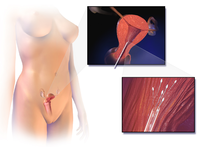
Photo from wikipedia
OBJECTIVE To determine the effect of stage of estrus cycle (day after ovulation) at the time of transvaginal ultrasound-guided follicle aspiration (TVA) on parameters related to the success of in… Click to show full abstract
OBJECTIVE To determine the effect of stage of estrus cycle (day after ovulation) at the time of transvaginal ultrasound-guided follicle aspiration (TVA) on parameters related to the success of in vitro equine embryo production. ANIMALS 14 healthy mares were used; 11 completed the study and were included for analysis. PROCEDURES Mares underwent TVA of all follicles ≥ 5 mm diameter at each of 3 timepoints: 7 days after ovulation, 14 days after ovulation, and S-DSF (subordinate to a dominant stimulated follicle), during estrus at 24 hours after gonadotropin administration. The 3 treatments were assigned to each mare in random order; mares underwent follicle growth and ovulation between treatments. Recovered oocytes were matured in vitro, subjected to intracytoplasmic sperm injection (ICSI), and cultured to the blastocyst stage in vitro. RESULTS Total follicle numbers differed significantly between individual mares but did not differ between treatments. The number of follicles of different sizes significantly (P < 0.05) differed between treatments, with mares in the Day 7 treatment having more follicles 5 to 9 mm in diameter and fewer follicles 20 to 24 mm in diameter than mares in the other 2 treatments. After in vitro maturation culture, there were significantly more mature oocytes in the S-DSF treatment than in the other 2 treatments. There were no differences in blastocyst rate after ICSI among treatment groups. CLINICAL RELEVANCE Timing of TVA for aspiration of S-DSFs may increase the number of mature oocytes available for ICSI. Understanding of the effects of timing of TVA will help veterinarians to maximize the efficiency of this procedure.
Journal Title: Journal of the American Veterinary Medical Association
Year Published: 2022
Link to full text (if available)
Share on Social Media: Sign Up to like & get
recommendations!